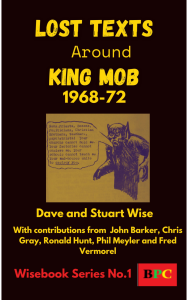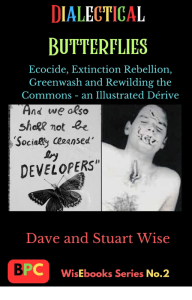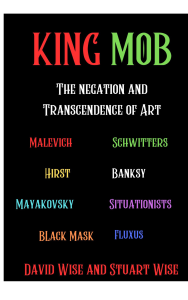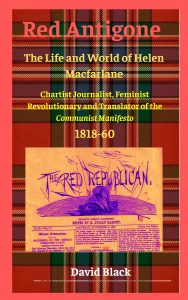B.P.C. Books Catalogue
Below are all B.P.C. titles -eleven in all – published to date (2022-2025) as paperback and ebook, available on Amazon and in world libraries via PublishDrive.

1839: The Chartist Insurrection and the Newport Rising, by David Black and Chris Ford, with an Introduction by John McDonnell M.P. (new edition of the book published by Unkant in 2012)
Buy at Amazon: Paperback and Kindle: HERE
March 2025

The Phantasmagoria of Capital: A Short History of the Commodity, the Spectacle and its Discontents, by David Black
Buy at Amazon: Paperback and Kindle: HERE
WiseBooks Series 1 -5
 Lost Texts Around King Mob, by Dave and Stuart Wise. with contributions from John Barker, Chris Gray, Ronald Hunt, Phil Meyler and Fred Vermorel
Lost Texts Around King Mob, by Dave and Stuart Wise. with contributions from John Barker, Chris Gray, Ronald Hunt, Phil Meyler and Fred Vermorel
Buy at Amazon: Paperback and Kindle: HERE
 Dialectical Butterflies: Ecocide, Extinction Rebellion, Green and Rewilding the Commons – an Illustrated Derive, by Dave and Stuart Wise.
Dialectical Butterflies: Ecocide, Extinction Rebellion, Green and Rewilding the Commons – an Illustrated Derive, by Dave and Stuart Wise.
Buy at Amazon: Paperback and Kindle: HERE
 King Mob: the Negation and Transcendence of Art, by Dave and Stuart Wise
King Mob: the Negation and Transcendence of Art, by Dave and Stuart Wise
Buy at Amazon: Paperback and Kindle: HERE
 A Newcastle Dunciad: Memories of Music and Recuperation, by Dave and Stuart Wise
A Newcastle Dunciad: Memories of Music and Recuperation, by Dave and Stuart Wise
Buy at Amazon: Paperback and Kindle: HERE
 Building For Babylon: Construction, Collectives and Craic, by Dave and Stuart Wise
Building For Babylon: Construction, Collectives and Craic, by Dave and Stuart Wise
Buy at Amazon: Paperback and Kindle: HERE
Helen Macfarlane
 Red Chartist: Complete Annotated Writings, and her Translation of the Communist Manifesto, by Helen Macfarlane
Red Chartist: Complete Annotated Writings, and her Translation of the Communist Manifesto, by Helen Macfarlane
Buy at Amazon: Paperback only: HERE
 Red Antigone: The Life and World of Helen Macfarlane 1818-60, by David Black
Red Antigone: The Life and World of Helen Macfarlane 1818-60, by David Black
Buy at Amazon: Paperback and Kindle: HERE
Psychedelic History
 Psychedelic Tricksters: A True Secret History of LSD, by David Black
Psychedelic Tricksters: A True Secret History of LSD, by David Black
Buy at Amazon: Paperback and Kindle: HERE
 LSD Underground: Operation Julie, the Microdot Gang and the Brotherhood of Eternal Love, by David Black
LSD Underground: Operation Julie, the Microdot Gang and the Brotherhood of Eternal Love, by David Black
Buy at Amazon: Paperback and Kindle: HERE

